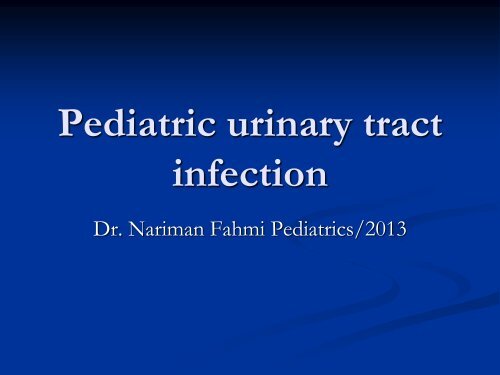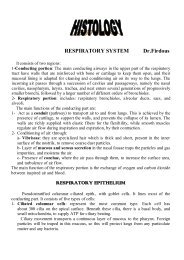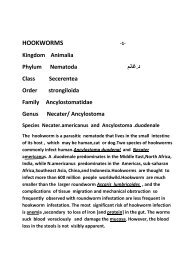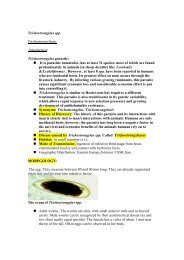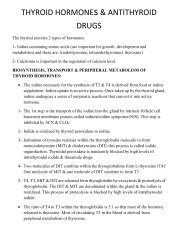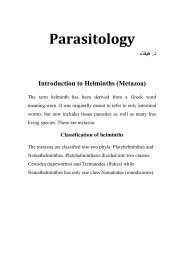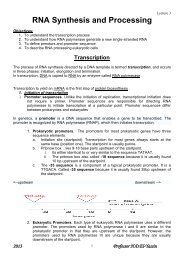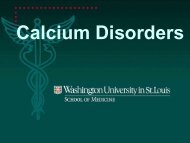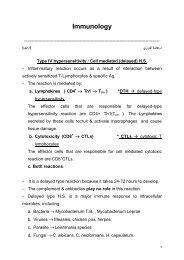Pediatric urinary tract infection
Pediatric urinary tract infection
Pediatric urinary tract infection
- No tags were found...
Create successful ePaper yourself
Turn your PDF publications into a flip-book with our unique Google optimized e-Paper software.
<strong>Pediatric</strong> <strong>urinary</strong> <strong>tract</strong><strong>infection</strong>Dr. Nariman Fahmi <strong>Pediatric</strong>s/2013
objectives• EPIDEMIOLOGY• CAUSATIVE PATHOGENS• PATHOGENESIS• CATEGORIES OF URINARY TRACT INFECTIONS ANDCLINICAL MANIFESTATIONS IN pediatrics• DIAGNOSIS• TREATMENT
EpidemiologyIncidence:•Boys: 1%-UTIs are much more common in uncircumcised boys.•Girls: 3–5% of girls
<strong>Pediatric</strong> UTIs• 7% of febrile neonates, have UTIs.Causative microorganism– E. coli (60-80%)– Proteus– Klebsiella– Enterococcus– coag. neg. staph.
The 3 basic forms of UTI are1-pyelonephritis2-Cystitis3-Asymptomatic bacteriuria
PyelonephritisClinical Features•Pyelonephritis is the most common serious bacterial<strong>infection</strong> in infants who have (fever without a focus)•1-Newborns may show nonspecificsymptoms such as poor feeding,irritability, and weight loss.•2-in children abdominal or flank pain,fever, malaise, nausea, vomiting, and,occasionally, diarrhea.
Cystitis (bladder involvement )clinical features• Dysuria, urgency, frequency, suprapubicpain, incontinence, and malodorous urine.• Cystitis does not cause fever and does notresult in renal injuries
Asymptomatic bacteriuria• positive urine culture without anymanifestations of <strong>infection</strong>.• It is most common in girls.• The incidence is 1–2% in girls0.03% in boys.
Risk Factors for Urinary Tract Infection• Female gender• Uncircumcised male• Vesicoureteral reflux• Toilet training• Voiding dysfunction• Obstructive uropathy• Urethral instrumentation• Wiping from back to front in females•
Risk Factors for Urinary Tract Infection• Bubble bath?• Tight clothing (underwear)• Pinworm infestation• Constipation• Bacteria with P fimbriae• Anatomic abnormality (labial adhesion)• Neuropathic bladder
General urine exam
Pus cells inurineMicroscopical exam
DIAGNOSIS• Urine culture• proper sample of urineMidstream toilet-trained childrencatheterized sampleSuprapubic aspiration
Definition of UTI on cultureMethod of urine collectionClean-catch in voiding girlsClean-catch in voiding boysCatheterSuprapubic aspirationDiagnostic threshold100,000 CFU per mL10,000 – 100,000 repeat culture10,000 CFU per mL10,000 CFU1,000 – 10,000 repeat cultureAny colonies of GNRsMore than a few thousand GPCsHillerstein S. Recurrent <strong>urinary</strong> <strong>tract</strong> <strong>infection</strong>s in children. Pediatr Infect Dis 1982; 1:275.
Pyelonephritis- leukocytosis, neutrophilia-elevated erythrocyte sedimentation rateand C-reactive protein are common.The latter two are nonspecific markers ofbacterial <strong>infection</strong>
Imaging of the Renal Tract in childrenThe goal of imaging studies in children with a UTI is toidentifyAnatomic abnormalities that predispose to <strong>infection</strong> andidentify scarring* Renal U/S* KUB* DMSA* Cystogram•VCUG/RNC* IVU
Who to image• All patients 2 months- 2 years with first UTI• Renal U/S , renal Cystogram• A typical UTI• Recurrent UTI
Plain KUBPROS Cheap Widely available Detects most stones[radio-op]CONS Radiation Poor information
Renal UltrasoundPROS Cheap Quick result No radiation Widely used Good for detectingGU anatomyCONS Not good for detectingVUR Requires cooperation
DMSArenal cortical scan(2-3 months following UTI)PROSDifferentiatepyelonephritissfrom cystitis-Assess renal scarCONS High radiation Difficult to interpret Require I.V injection
Cystogram• Detect identify and grade vesicouretericreflux
enal image.lnk
Reflux Seen onVoidingCystourethrogram(VCUG) usingtransurethralcontrast
Grades of VUR
adionuclide VCUGPROS Highly sensitive Very low radiationCONS Still requires catheter
IVUPROS Widely available Demonstrates renal <strong>tract</strong>and some scarring Calyceal dilatation Filling defectCONS High radiation Allergic reaction Requires i.v. injection Poor visualisation of scars
Treatment of UTI - Aims- Rapid treatment toprevent spread to upper RT and prevent renal scar- Early detection of abnormalities-Arrange appropriate investigation- Prevent recurrence- Correct mechanical obstruction- Appropriate follow up
Antimicrobial Chemotherapy of UTI in childrenAcute treatment Dose Dosing interval Prophylaxisiv Cefotaxime 100 mg/kg/day 8 hoursiv Ampicillin +iv Gentamicin50 - 100mg/kg/day2 mg/kg/day6 hours(depends onrenal function +plasma conc.)Oral8 mg/kg/day 12 hours 1 - 2 mg/kg/nocteTrimethoprimCephradine 50 mg/kg/day 6 - 12 hoursNalidixic acid 50 mg/kg/day 6 hours 12.5 mg/kg/nocteNitrofurantoin 3 mg/kg/day 6 hours 1 mg/kg/nocteCo-amoxiclav 25 mg/kg/day 6 hours
TREATMENT• Acute cystitis should be treated promptly toprevent possible progression to pyelonephritis.• If the symptoms are severe, a specimen of bladderurine is obtained for culture, and treatment isstarted immediately.• If the symptoms are mild or the diagnosis isdoubtful, treatment can be delayed until the resultsof culture are known
• If treatment is initiated before the results of aculture and sensitivities are available, a 3- to 5-daycourse of therapy with• trimethoprim-sulfamethoxazole is effective againstmost strains of E. coli.• Nitrofurantoin (5–7 mg/kg/24 hr in 3 to 4 divideddoses) also is effective and has the advantage ofbeing active against Klebsiella-Enterobacterorganisms.• Amoxicillin (50 mg/kg/24 hr)
Acute febrile <strong>infection</strong>s suggestive ofPyelonephritisA 10- to 14-day course of broad-spectrumantibiotics capable of reaching significanttissue levels is preferable.
When to admit to hospital?Admit when systemically ill child with:-symptoms suggestive of Pyelonephritis-vomiting , dehydration or are unable to drinkfluids• Young infants (Age ≤1 mo of age)• sepsis
The main consequences of Pyelonephritischronic renal damagewhich is presented as-Arterial hypertension and renalinsufficiencyso Pyelonephritis should be treatedappropriately
• Atypical UTI• Recurrent UTISome definitions
Atypical UTI includes:• • seriously ill child( septicemia)• • poor urine flow• • abdominal or bladder mass• • raised creatinine• • failure to respond to treatment withsuitable antibiotics within 48 hours• • <strong>infection</strong> with non-E. coli organisms.
Recurrent UTI:• two or more episodes of acutePyelonephritis• Or one episode of acute pyelonephritisplus one or more episode of cystitis• Or three or more episodes of cystitis
prophylaxisprophylactic antibiotic• Used for Patients with vesicouretericreflux because they have recurrent UTI
THANK YOU


